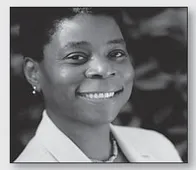Chapter Road Map
Case: Ursula Burns—Xerox's Inspiring Leader
What Is Leadership?
Leadership as Power and Influence
Leaders as Representatives and Problem Solvers
Leadership and Power Differences Around the Globe
Levels of Leadership
Check Your Egos at the Door: Leader Development Occurs at Every Level
Leader Development and Mentors
Some Specific Types of Leaders
What Do We Want From Leaders? Genuine Concern
Leaders Matter
Case: Spotlight on Sustainable Practices
Personal Reflections: It's Easy to Become a Leader!
Values, Ethics, and Corporate Social Responsibility
Evidence-Based Leadership
The Best of Every Theory
Case: Jib Ellison (Environmentalist) and Lee Scott (Former CEO, Wal-Mart):
Sustainability Saves Money and the Environment
Put It in Practice
Exercises: (1) Perceptions of Leaders and (2) Leaders as Role Models
Case: Ursula Burns—Xerox's Inspiring Leader
Few CEO's have a more inspiring life story than Ursula Burns. In July of 2009, she was named CEO of Xerox—the first African American woman to be CEO of such a large Fortune 500 company. She rose to an even higher rank when she added the Xerox chairwoman duties to her CEO role on May 20, 2010. But she didn't start at the top, and she wasn't born with a silver spoon in her mouth. Her mother was of Irish and German American heritage, and her father was African American. Ursula was raised by her single mother in a New York City housing project. Although she grew up in a tough neighborhood, her mother inspired her to be a success. Ursula recalls her mother frequently stating, “Where you are is not who you are” (Bryant, 2010). Her mother also taught her two important lessons: the first about being a good person and the second about being successful. Her mother taught her that she needed to give back to the world more than she received from it. In terms of success, her mother encouraged her to be curious, to get a good education, and to not see herself as a victim.
Ursula Burns, Chairwoman and CEO of Xerox
Source: Wikipedia/U.S. Government Printing Office, 2004
Ursula followed her mother's advice about education by earning degrees in engineering from Polytechnic Institute of New York University and from Columbia University. And it was Ursula's curiosity and forthright speaking manner that attracted the attention of her first mentor at Xerox, Wayland Hicks, a corporate vice president who made her his executive assistant and protégé. Later, her curiosity and willingness to ask tough questions favorably impressed the president of Xerox at that time, Mr. Allaire. President Allaire had declared during his monthly executive meetings that Xerox would stop hiring people, yet Burns noticed that Xerox kept hiring a thousand people a month. She boldly asked him why Xerox was still hiring more people. President Allaire rewarded her honesty by making her his own executive assistant. Ursula Burns credits both Hicks and Allaire with teaching her leadership skills. Together, they taught her about the need to communicate diplomatically with others and to give credit to others as a way of motivating them. As their executive assistant, she could learn by example from watching them lead Xerox.
During the 1990s, Ursula was assigned to lead important projects and she supervised teams in two of Xerox's high growth areas: faxes and office network printing. In 1999, she became vice president of Xerox's global manufacturing. Then, Xerox went through some turbulent times with accounting scandals, falling stock prices, and even rumors of impending bankruptcy. Burns thought about leaving, but she felt an obligation to help Xerox survive. Fortunately, Xerox soon thereafter made Anne Mulcahy CEO, and she and Ursula developed a true partnership in their efforts to transform Xerox. Ursula was given rapid promotions and was placed in charge of important initiatives, and for the next several years, Anne and Ursula worked together before Anne passed the CEO job (and then the chairwoman title) on to Ursula.
Ursula has continued to be recognized for her outstanding leadership, and in March 2011, she was recognized by Working Mother Magazine as one of the Most Powerful Moms in STEM (Science, Technology, Engineering, and Math). Truly, she's an inspiration for us all.
Applications: Ursula's mother taught her to be both a good person and to be successful. Can being a good person who wants to give back to others help one succeed? Ursula was good at establishing mentorship relations early in her career. How important is it to have mentors who can teach you leadership skills? What are the best ways to establish a mentorship relationship with senior leaders? Are there any leaders you can learn from?
Sources: NPR Staff. (2012, May 23). Xerox CEO: ‘If you don't transform, you're stuck’. Retrieved from http://www.npr.org/2012/05/23/153302563/xerox-ceo-if-you-don-t-transform-you-re-stuck
Bourne, L. (2011, February). Most powerful moms in STEM. In H. Jonsen (Ed.), Working Mother. Retrieved from http://www.workingmother.com/BestCompanies/most-powerful-moms/2011/02/most-powerful-moms-in-stem
Bryant, A. (2010, February 21). Xerox's new chief tries to redefine its culture. The New York Times. Retrieved from http://www.nytimes.com/2010/02/21/business/21xerox.html?_r=1
Burns, Ursula. Retrieved April 3, 2011 from http://en.wikipedia.org/wiki/Ursula_Burns
As the preceding case illustrates, Ursula Burns developed her leadership skills throughout her life. She was particularly good at establishing protégé-mentorship relationships with her superiors. She also illustrates some of the best qualities of leaders. In particular, she is forthright in her communications, which allows her to establish good ties with others and to influence them as well. As the definition of leadership below illustrates, the ability to influence others is one of the key attributes of leadership. She also represents Xerox's corporate values by believing in the value of education and innovation, and her dedication to helping Xerox survive during tough times shows her commitment to the organization. As we'll see from the following definitions, leaders also help their group, organization, or society fulfill their mission. This chapter will also discuss some of the following key questions:

